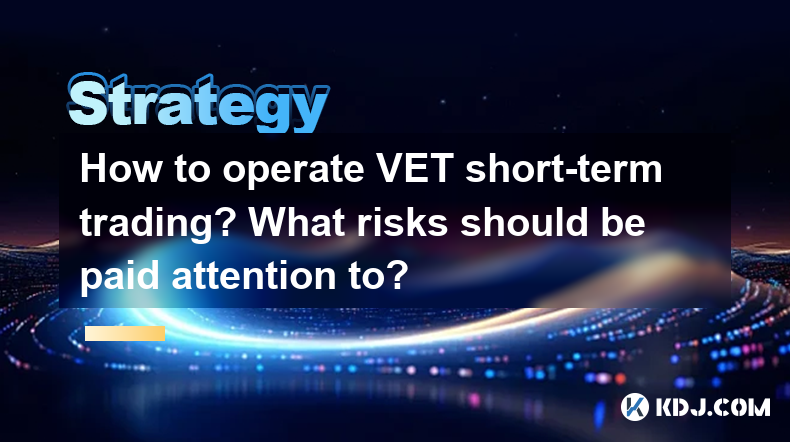-
 bitcoin
bitcoin $108842.957301 USD
-1.88% -
 ethereum
ethereum $3931.777121 USD
-1.66% -
 tether
tether $1.000186 USD
-0.03% -
 bnb
bnb $1153.250882 USD
-2.20% -
 xrp
xrp $2.367904 USD
-1.94% -
 solana
solana $186.182050 USD
-4.20% -
 usd-coin
usd-coin $0.999997 USD
0.00% -
 tron
tron $0.316949 USD
-1.00% -
 dogecoin
dogecoin $0.190780 USD
-3.12% -
 cardano
cardano $0.651324 USD
-2.67% -
 hyperliquid
hyperliquid $37.141055 USD
-0.85% -
 ethena-usde
ethena-usde $0.999224 USD
-0.09% -
 chainlink
chainlink $17.579031 USD
-2.47% -
 bitcoin-cash
bitcoin-cash $509.426284 USD
-2.79% -
 stellar
stellar $0.315298 USD
-2.93%
How to operate VET short-term trading? What risks should be paid attention to?
Short-term trading VET involves buying and selling within days to capitalize on price fluctuations, but be aware of market volatility and liquidity risks.
May 04, 2025 at 07:07 am

Short-term trading in the cryptocurrency market, particularly with VeChain (VET), can be an exciting yet challenging endeavor. This article will guide you through the process of operating VET short-term trading and highlight the risks you should be aware of. Whether you are a seasoned trader or a newcomer, understanding these aspects is crucial for making informed decisions.
Understanding VET and Short-Term Trading
VeChain (VET) is a blockchain platform that aims to enhance supply chain management and business processes through the use of distributed ledger technology. Short-term trading involves buying and selling VET within a short period, typically ranging from a few minutes to a few days, to capitalize on price fluctuations.
To engage in short-term trading of VET, you need to have a clear understanding of the market dynamics and the factors that influence VET's price. This includes staying updated with news related to VeChain, understanding technical analysis, and being aware of the overall market sentiment.
Setting Up for VET Short-Term Trading
Before you start trading VET, you need to set up the necessary tools and accounts. Here's how you can do it:
- Choose a Reliable Exchange: Select a cryptocurrency exchange that supports VET trading. Popular options include Binance, Huobi, and KuCoin. Ensure the exchange has a good reputation, low fees, and a user-friendly interface.
- Create and Verify Your Account: Sign up for an account on the chosen exchange. You will need to provide personal information and complete the verification process, which may include submitting identification documents.
- Deposit Funds: Once your account is verified, deposit funds into your exchange wallet. You can use cryptocurrencies like Bitcoin or Ethereum, or fiat currencies if the exchange supports it.
- Set Up a Trading Interface: Most exchanges offer a trading interface where you can buy and sell VET. Familiarize yourself with the interface, including order types (market, limit, stop-loss) and chart analysis tools.
Executing VET Short-Term Trades
Once you have set up your trading environment, you can start executing short-term trades. Here's a step-by-step guide:
- Analyze the Market: Use technical analysis tools to identify potential entry and exit points. Look for patterns, trends, and indicators that suggest a good time to buy or sell VET.
- Place Your Order: Decide on the type of order you want to place. A market order will execute immediately at the current market price, while a limit order allows you to set a specific price at which you want to buy or sell. A stop-loss order can help limit potential losses by automatically selling VET if the price drops to a certain level.
- Monitor Your Trades: Keep a close eye on your trades and the market. Short-term trading requires constant monitoring, as prices can change rapidly.
- Close Your Position: Once you reach your desired profit or if the market moves against you, close your position by selling your VET. Be disciplined and stick to your trading plan.
Risks Associated with VET Short-Term Trading
While short-term trading can be profitable, it comes with significant risks that you should be aware of:
- Market Volatility: The cryptocurrency market, including VET, is highly volatile. Prices can fluctuate dramatically in a short period, leading to potential losses.
- Liquidity Risks: If the market for VET is not liquid enough, you may struggle to buy or sell at your desired price, which can impact your trading strategy.
- Technical Failures: Exchanges and trading platforms can experience technical issues, such as downtime or glitches, which can prevent you from executing trades at critical moments.
- Emotional Trading: Short-term trading can be emotionally taxing. Fear and greed can lead to impulsive decisions, resulting in losses. It's important to maintain discipline and stick to your trading plan.
Managing Risks in VET Short-Term Trading
To mitigate the risks associated with VET short-term trading, consider the following strategies:
- Use Stop-Loss Orders: Implementing stop-loss orders can help limit your losses by automatically selling VET if the price drops to a certain level.
- Diversify Your Portfolio: Don't put all your funds into VET. Diversify your investments across different cryptocurrencies to spread the risk.
- Stay Informed: Keep up-to-date with news and developments related to VeChain and the broader cryptocurrency market. This can help you make more informed trading decisions.
- Practice with a Demo Account: Many exchanges offer demo accounts where you can practice trading without risking real money. Use this to hone your skills and test your strategies.
Tools and Resources for VET Short-Term Trading
To enhance your short-term trading experience with VET, consider using the following tools and resources:
- Trading Bots: Automated trading bots can execute trades based on predefined criteria, helping you take advantage of market opportunities 24/7.
- Technical Analysis Software: Tools like TradingView and MetaTrader offer advanced charting and analysis features that can help you identify trading opportunities.
- Cryptocurrency News Platforms: Websites like CoinDesk and CryptoSlate provide up-to-date news and analysis on the cryptocurrency market, including VET.
- Trading Communities: Joining online forums and communities can provide valuable insights and support from other traders.
Frequently Asked Questions
Q: Can I use leverage when trading VET short-term?A: Yes, some exchanges offer leverage for trading VET, allowing you to borrow funds to increase your trading position. However, using leverage amplifies both potential gains and losses, so it should be used cautiously.
Q: How much capital do I need to start short-term trading VET?A: The amount of capital needed can vary depending on your trading strategy and risk tolerance. It's recommended to start with an amount you can afford to lose, as short-term trading can be risky.
Q: Is it possible to trade VET short-term on a mobile app?A: Yes, many cryptocurrency exchanges offer mobile apps that allow you to trade VET on the go. Ensure the app is secure and offers the features you need for short-term trading.
Q: How often should I monitor my VET short-term trades?A: Short-term trading requires frequent monitoring, ideally in real-time. However, the exact frequency can depend on your trading strategy and the volatility of the market.
Disclaimer:info@kdj.com
The information provided is not trading advice. kdj.com does not assume any responsibility for any investments made based on the information provided in this article. Cryptocurrencies are highly volatile and it is highly recommended that you invest with caution after thorough research!
If you believe that the content used on this website infringes your copyright, please contact us immediately (info@kdj.com) and we will delete it promptly.
- Cardano, Dogecoin, and the Token Rally: What's the Hype?
- 2025-10-17 22:45:16
- Milk Mocha Meme Coin: Last Call for Whitelist & Early HUGS Gains!
- 2025-10-17 22:45:16
- Crypto's New Sweetheart: Milk & Mocha's $HUGS Token and the Early Rounds Advantage
- 2025-10-17 22:25:12
- Crypto Picks for 2025: Blazpay Presale and Emerging Trends
- 2025-10-17 22:50:12
- Meme Coins: Riding the Early Bird Gold Rush
- 2025-10-17 23:05:12
- Shannon Man, Cash Prizes, and Coin Games: A New York Minute on a Georgia Arrest
- 2025-10-17 22:50:12
Related knowledge

Practical parameter settings for a Bitcoin multi-timeframe moving average system
Sep 18,2025 at 10:54pm
Optimizing Timeframe Combinations for Bitcoin Trading1. Selecting appropriate timeframes is crucial when building a multi-timeframe moving average sys...

How can I filter out false breakouts in Dogecoin high-frequency trading?
Sep 22,2025 at 01:00am
Understanding False Breakouts in Dogecoin Trading1. A false breakout occurs when Dogecoin's price appears to move beyond a defined support or resistan...

Techniques for identifying tops and bottoms in the Bitcoin on-chain NVT model
Sep 20,2025 at 07:54pm
Understanding the NVT Model in Bitcoin Analysis1. The Network Value to Transactions (NVT) ratio is often described as the 'P/E ratio' of the cryptocur...

What does the surge in open interest in Bitcoincoin futures mean?
Sep 20,2025 at 11:18pm
Understanding the Surge in Dogecoin Futures Open Interest1. A surge in open interest within Dogecoin futures indicates a growing number of active cont...

How can I use the Ethereum USDT premium to gauge market sentiment?
Sep 18,2025 at 11:55pm
Understanding the Ethereum USDT Premium1. The Ethereum USDT premium refers to the price difference between USDT (Tether) traded on Ethereum-based plat...

What should I do if Ethereum staking yields decline?
Sep 20,2025 at 06:18am
Understanding the Causes Behind Declining Ethereum Staking Yields1. The Ethereum network transitioned to a proof-of-stake consensus mechanism with the...

Practical parameter settings for a Bitcoin multi-timeframe moving average system
Sep 18,2025 at 10:54pm
Optimizing Timeframe Combinations for Bitcoin Trading1. Selecting appropriate timeframes is crucial when building a multi-timeframe moving average sys...

How can I filter out false breakouts in Dogecoin high-frequency trading?
Sep 22,2025 at 01:00am
Understanding False Breakouts in Dogecoin Trading1. A false breakout occurs when Dogecoin's price appears to move beyond a defined support or resistan...

Techniques for identifying tops and bottoms in the Bitcoin on-chain NVT model
Sep 20,2025 at 07:54pm
Understanding the NVT Model in Bitcoin Analysis1. The Network Value to Transactions (NVT) ratio is often described as the 'P/E ratio' of the cryptocur...

What does the surge in open interest in Bitcoincoin futures mean?
Sep 20,2025 at 11:18pm
Understanding the Surge in Dogecoin Futures Open Interest1. A surge in open interest within Dogecoin futures indicates a growing number of active cont...

How can I use the Ethereum USDT premium to gauge market sentiment?
Sep 18,2025 at 11:55pm
Understanding the Ethereum USDT Premium1. The Ethereum USDT premium refers to the price difference between USDT (Tether) traded on Ethereum-based plat...

What should I do if Ethereum staking yields decline?
Sep 20,2025 at 06:18am
Understanding the Causes Behind Declining Ethereum Staking Yields1. The Ethereum network transitioned to a proof-of-stake consensus mechanism with the...
See all articles










































































